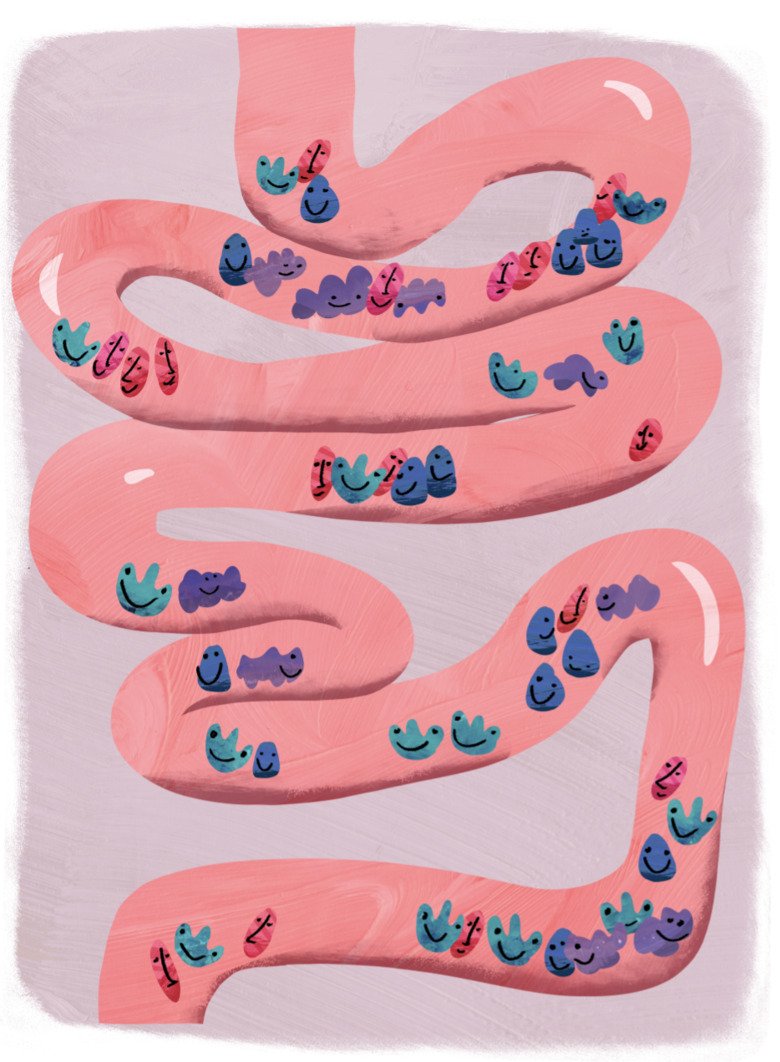Your guide to the allergy jungle
Research points to increasing problems relating to hypersensitivity to food, especially food allergies. At the same time, more people than necessary have been categorised as having allergies. Better diagnostics are coming out, as are new ideas regarding both prevention and treatment.

Text: Fredrik Hedlund, first published in Swedish in Medicinsk Vetenskap No 4/2018.
Hypersensitivity is common in Sweden. As many as one in four people in Sweden, both young people and adults, report in various surveys that they have a hypersensitivity to some food or drink.
Hypersensitivity is a type of umbrella term that covers both immunological reactions – primarily allergies – and non-immunological – mainly intolerances. The allergies are often linked to the antibodies of the immune system, which are usually mediated through specific antibodies called immunoglobulin E, or IgE, but there are also allergies that are not IgE-mediated.
The wide range of different reactions included in the term hypersensitivity makes it somewhat ambiguous, and there is some confusion about the various conditions. Especially as the same food can cause both allergies and intolerances. There are for example people who are allergic to milk protein, while others are lactose intolerant. Both are hypersensitive to milk and dairy, but suffer from completely different conditions. There are those who are gluten intolerant, while others are allergic to wheat. None of them can eat bread, but for vastly different reasons, and so on.
Different causes
Food intolerances are in turn due to different causes and they differ in severity. Gluten intolerance, for example, is caused by an autoimmune disease, which in case of continued ingestion can harm the intestines and consequently result in malnutrition. Lactose intolerance in adults, on the other hand, is a completely natural process. This is because the older we get, the less our bodies produce of the enzyme lactase, which is responsible for breaking down lactose.

In many parts of the world, this is normal; there is no use in being able to digest lactose, as milk is not consumed after early childhood. It is considered hypersensitivity in Sweden simply because nine out of ten Swedes retain the ability to break down lactose into adulthood, something that makes us rather unusual from a global perspective.
“Lactose intolerance is a perfectly natural condition in adults, meaning that it is not an illness,” says Caroline Nilsson, paediatric allergist at Sachs’ Children and Youth Hospital and Docent at the Department of Clinical Science and Education, Södersjukhuset, Karolinska Institutet, and chair of the Swedish Association for Allergology.
Much of today’s research concerns the types of food hypersensitivity that constitute allergies. Among these allergies, the IgE-mediated allergies are the most serious, as they can lead to a potentially life-threatening reaction called anaphylaxis. This is also the reason why these IgE-mediated food allergies are the most researched and of the greatest interest to many doctors.

“Our task is to identify the conditions that are potentially life-threatening. It is medically important to identify those with an underlying food allergy, where there is a risk of serious reactions, says Erik Melén, paediatric allergist at Sachs’ Children and Youth Hospital, Docent at the Institute of Environmental Medicine at Karolinska Institutet and research leader of the BAMSE study. The BAMSE study involves 4,000 children who have been monitored since birth during the period 1994–1996. Right now, the study is doing a follow-up 24 years in. The study has been incredibly important in increasing the knowledge of how lifestyle, environment and genetics influence the development of allergies and asthma.
International studies have indicated that food allergy is a growing problem, and some researchers are referring to it as the “second wave of the allergy epidemic” – after asthma. Severe allergic reactions to food were uncommon 35–40 years ago, and today they are the primary reason for hospitalisation and anaphylaxis in the United States, where around 200 people annually die from an allergic reaction to food.
At the same time, it is not entirely clear how common food allergies actually are. The diagnostics have changed rather drastically over the last decades, and knowledge about correlations and what does and does not constitute an allergy has also changed over time; something which makes comparison difficult.
Reddening of the skin
Thirty years ago, food allergies were diagnosed using a skin-prick test, which involves perforating the skin and exposing the tissue to the substances the child was suspected to be allergic to. Reddening of the skin indicated the presence of IgE antibodies. However, when it comes to showing if someone is actually allergic to certain foods, prick tests are unreliable.
The diagnostics were later developed, using blood samples to determine the presence of IgE antibodies in a more sophisticated way. But this type of blood sample, which was only starting to be replaced a few years ago, would only measure the amount of antibodies against the whole allergen, which contains several different proteins, which meant that this test too had a far from perfect accuracy. It showed the presence of antibodies against the allergen in the blood, but said nothing about whether or not they caused an allergy.
“More than half of those who have the antibodies show no symptoms, and if you don’t have any symptoms, you’re not allergic. You have to have both the antibodies and the symptoms to have an allergy. If you only have the antibodies, we call it being sensitised,” says Caroline Nilsson.
However, in recent years, the diagnostics have been developed even further, and it is now possible to use a blood sample to isolate antibodies against specific proteins or carbohydrates in certain foods, which has significantly increased the accuracy.
“Out of those proven through modern diagnostics to have IgE antibodies against single peanut proteins, 90 per cent are allergic to peanuts,” says Caroline Nilsson.
But for many foods, there is still no detailed test, so the only sure way of determining whether a person really has an allergy is to subject them to a test called a double blind placebo-controlled food challenge. The test involves giving the patient small amounts of either a completely harmless food or the food that it is suspected the patient is allergic to without the doctor or the patient knowing which is which.
If the patient is allergic, they will have a reaction, in the worst case a serious allergic reaction, which is why this test can be a fairly unpleasant experience and must be carried out in the hospital. For obvious reasons, not all patients are willing to undergo a test like this, and the health service does not have the resources to administer the test to all patients with suspected allergies. As a consequence, many people in Sweden have been given an allergy diagnosis that is far from foolproof.
Outgrown their allergy
A Swedish study from 2015 looked at just over 2,600 school children between the ages of 11 and 12 years. According to information from the parents, a little under five per cent of the children had an allergy to milk, eggs, cod or wheat. However, after administering a test using a double blind placebo-controlled food challenge, the researchers were able to establish that only 0.6 per cent, i.e. only one of eight of the children who believed they were allergic, actually had a food allergy. Seven of eight of the supposedly allergic school children had either outgrown their allergy or had never been allergic in the first place.
This does not mean that information on food allergy should be taken with a grain of salt, because for those who really are allergic it is still potentially a matter of life or death. However, it does mean that many indications of the size of the problem are uncertain. It also means that many more people than what may be necessary are excluding different foods from their diet.
Something that takes its toll, both financially and mentally. This has been shown in research from Karolinska Institutet. Children and young people with food allergies, and their parents, as well as adults with food allergies, are experiencing a lower quality of life compered to the average. The main reason for this is the pressure entailed by being constantly aware of the food around you, knowing that one incorrect decision can lead to a life-threatening reaction. It seems to matter little that the risk is very low.

“The risk of dying from food-related anaphylaxis is statistically lower than being struck by lightning. But for a person with a food allergy, it will never feel like zero risk,” saysJennifer Protudjer, research assistant in paediatric health at the University of Manitoba, Canada, and associated researcher at the Institute of Environmental Medicine at Karolinska Institutet.
A person with IgE-mediated food allergy may need to carry two autoinjectors, a type of automatic syringe with adrenaline that is injected into the thigh at the onset of an anaphylactic reaction; something which reminds them everyday of the severity of the allergy.
Jennifer Protudjer’s research shows that the need for constant vigilance removes some of the joy in life.
“Parents of children with food allergies are constantly worrying that something could happen in preschool or school, and young people say they feel limited in making new social contacts and having new experiences without their parents present. Adults with food allergies say that they are worried about trying new things,” she says.
Food allergy also costs money. Special diets are often more expensive than regular food, and autoinjectors cost money and need to be changed regularly even if they have not been used. In this regard, Jennifer Protudjer views Sweden as a role model, having made all prescription medicine for children free of charge since 2016, including autoinjectors.
“By removing this cost, Sweden has taken a leap forward for families who have children with food allergies. In other countries, the cost can be rather large, and some families cannot afford autoinjectors,” she says.
She says that in Canada, an autoinjector costs the equivalent of SEK 700, and in the United States SEK 5,500, and each patient needs at least two per year.
And then there are additional indirect costs, such as time loss due to health service visits and cooking at home, which those with food allergies do much more often, as it is safer, even though it is much faster to eat in a restaurant.
Researchers still do not know why food allergy occurs, even if the actual immunological process is fairly well-known. When a human encounters an allergen — an allergenic agent — a number of times, the body’s immune system starts to produce IgE antibodies against it. Once the immune defence has produced a sufficient amount of antibodies, the allergy is a fact. But the question of why the immune defence starts producing antibodies against food is a tougher nut to crack.
The hygiene hypothesis
One of the leading hypotheses, often called the hygiene hypothesis, which is also argued as the cause of asthma, states that modern life is too clean, which causes the under-stimulated immune defence to overreact to things that should not be a problem. Without a doubt, there is a genetic factor involved.
“It is often said that if both the mother and father have allergies, the risk of their children also having allergies is between 50 and 75 per cent,” says Caroline Nilsson.

One popular explanation is that this has something to do with the intestinal flora. The intestinal flora is believed to have been gradually depleted by modern life, and this is inherited from one generation to the next, even if it is not in our genes.
“We need to have lots of different bacteria in our intestinal flora, this is a proven fact. The fewer types of bacteria and subgroups you have in your intestines, the greater the risk of having allergies,” says Caroline Nilsson.
But whether or not a depleted gut flora is to blame here remains to be proven. A recently published Swedish study could provide evidence that the intestinal flora actually plays a part. In a large register study of one million births in Sweden between 2001 and 2012, the researchers have been able to show that children born through caesarean had around a 20 per cent higher relative risk of developing some form of food allergy.
In concrete numbers, this means that of the children born full term through vaginal delivery, 24 of 1,000 developed a food allergy, while the corresponding number for those born through caesarean section was 29 of 1,000. Not a massive increase perhaps, but still a clearly statistically significant increased risk.
The theory relating to the gut flora is that the newborn infant is given the mother’s bacterial flora partly when passing through the birth canal, and partly because the infant usually comes into contact with the mother’s intestinal bacteria during birth.
“This study is important because it is very large. It confirms earlier findings from smaller studies showing that the delivery method can have an impact on the risk of later development of food allergies, and that the caesarean entails an increased risk,” says Erik Melén, who is one of the authors of the study.
Extremely preterm infants
But he would also like to highlight another result found in the study, which shows that extremely preterm infants, regardless of delivery method, have a lower risk of developing food allergies. Among the preterm infants, only 19 of 1,000 had later developed a food allergy, which is a relative risk decrease of 26 per cent.
“This has been observed and known among paediatricians, but there have been no good studies to prove it. This is the first major study that is able to show that correlation. It is interesting to show that preterm birth can have positive health effects in terms of a lower risk of developing food allergy.”
And this find also fits well into another hypothesis on why we develop food allergies. Namely the benefit of introducing solid food early in life.
“We believe that there is some link to preterm infants being introduced to food at a very early age, while they have immunologically immature intestines. And that this in turn could lead to them developing a tolerance. They do not develop allergies, but become tolerant, because their body comes into contact with the foods early on,” says Erik Melén.
For anyone who has had a child in the last 30 years, this sounds very odd. Before, all new parents were advised to avoid giving their baby foods like eggs, fish and nuts before the age of one to two years.
“The earlier recommendation was to avoid these if there was an increased risk, but contrary to that advice, it has now been proven that you can reduce the risk by introducing these foods early and regularly,” he says.
One very important reason for this paradigm shift is a study published in 2015, in which British and American researchers randomly selected 530 infants with a high risk of developing food allergies to either be given peanuts in different forms from the age of four months, or not at all up until the age of five. It turned out that close to 14 of 100 children who avoided peanuts developed a peanut allergy, whereas only 2 of 100 who got to try peanuts did.
“What you need to remember is that the study only included risk children”, says Caroline Nilsson.
What she means is that the effect may have been particularly large in a group of children with high risk of allergies, and that it is important to be careful when drawing any conclusions outside that group. She continues to say that there has been a similar study on regular children, where the parents were selected at random to introduce peanuts, milk, eggs, wheat, fish and sesame seeds at the age of three months or at six months, but it turned out to be too difficult for the parents to follow all of the instructions. For this reason, the results indicate no major differences, except in the smaller group of children whose parents really followed the instructions, where the prevalence of allergy to peanuts and eggs was lower.
The Preventadall study
An ongoing Swedish/Norwegian study is also looking into this question. The Preventadall study, which stands for “Preventing Atopic Dermatitis and Allergies in Children” will investigate two completely different measures and their significance in the development of dermatitis and food allergy. The idea is to monitor 2,500 regular Swedish and Norwegian children from as early as gestation week 18 and researchers are to study the extent to which oil baths followed by rehydrating moisturiser and early introduction to foods impact the development of food allergy.
The children are randomly divided into four groups, where one group is given oil baths, one group is introduced to food early on, one group is given both, and the last group is a control group that receives neither of the measures. The hypothesis is that a deteriorated skin barrier, which occurs in dermatitis and dry skin, makes it possible for allergens to penetrate the skin and influence the immune system, which in turn leads to the development of allergies.

“We often talk about the atopic march, which begins with dermatitis and continues to food allergy followed by asthma and pollen allergy later on. The atopic march has been discussed for more than 20 years, but there haven’t been any in-depth studies to investigate it,” says Björn Nordlund, paediatric nurse at the Department of Women’s and Children’s Health at Karolinska Institutet and research group leader for Preventadall in Sweden.
Unlike the previous study on early introduction of food, which had an excessively complex schedule for the participants to follow, the protocol of this study will be simple.
“It is enough to start introducing foods from the age of three months. You start with peanut butter in the first week, then you add something with milk, such as plain yogurt, in the second week. Then another addition of something that contains wheat in week three, and finally you add cooked egg in week four,” he says.
All the foods are then introduced before the child is four months old, and then you continue with these foods until the children are six months old, and then the families are free to continue giving them peanuts, milk, wheat and eggs.
There will be no results on how the development of food allergies is impacted by these different measures until 2020, at the earliest. But there are many indications that early introduction is good.
The current recommendation is that you can start introducing the child to small portions of what the rest of the family is eating starting from four months old. But the question is whether the advice needs to be changed. Sweden’s National Food Administration is currently reviewing the recommendations and is expected to have completed this work in the latter part of 2018 or early 2019.
Oral immunotherapy
Naturally, it is a great advantage to find new and simple ways of preventing the development of food allergies, but it does not help those who already suffer from allergies. For most sufferers, life will be about avoiding ingestion of the food in question. But there are also ways of treating and perhaps even curing food allergies.

Caroline Nilsson says that there is a treatment called oral immunotherapy, which entails giving the patient extremely small amounts of the food they are allergic to and increasing the amount over time in order to get the patient’s body used to it.
“This is a very demanding treatment, with lots of side effects, and it’s unclear whether it is actually a cure. But it at least desensitises the patient, and they can get to the stage where they can tolerate the food as long as the treatment continues,” she says.
But she has other ideas on future treatment. On a trial basis, she has been using a drug approved for use against severe asthma, an anti-IgE antibody called Xolair (omalizumab) for some 20 patients suffering from severe peanut allergy, in addition to their oral immunotherapy. Omalizumab bonds with IgE and thus dampens or prevents the allergic reaction. After two to six months of immunotherapy in combination with omalizumab, the patients were able to eat peanut with only mild reactions, or none at all. However, one issue is that the drug is fairly expensive; it costs up to SEK 350,000 per year. Another problem is that it has not been approved for allergy treatment, and it must be given as an injection at a hospital or health centre.
“Considering that the treatment can actually save lives, perhaps it is worth the money? In any case, it provided effective protection against peanut allergy,” says Caroline Nilsson.
However, the drug patent has just expired, so Caroline Nilsson is hoping that cheaper copies will be produced in the future which will make it more realistic to use. But there is no guarantee that the price will go down dramatically, as it is a complicated drug to manufacture.
“There is a risk that omalizumab will be reserved for patients who have several food allergies combined with severe asthma. The others will have to complete the oral immunotherapy without the protection of the drug,” she says.
